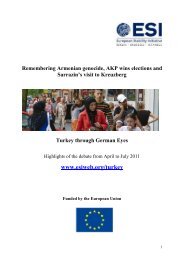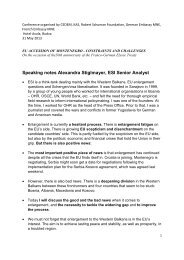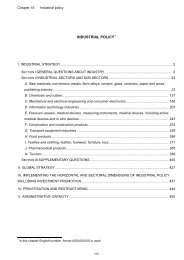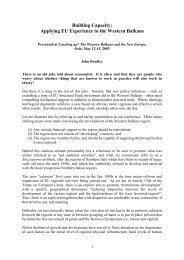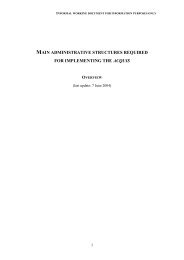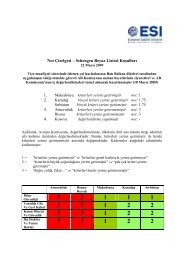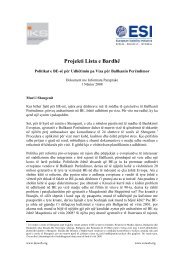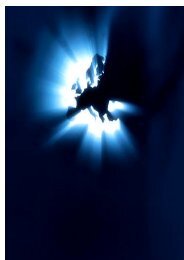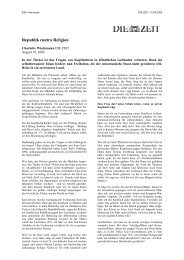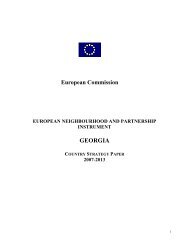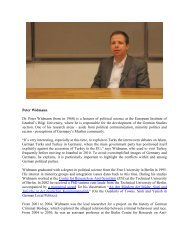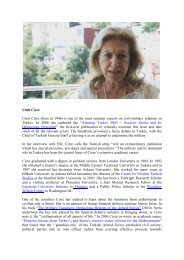Gender Assessment for USAID/Caucasus/Azerbaijan
Gender Assessment for USAID/Caucasus/Azerbaijan
Gender Assessment for USAID/Caucasus/Azerbaijan
Create successful ePaper yourself
Turn your PDF publications into a flip-book with our unique Google optimized e-Paper software.
commitment to equal access and opportunities <strong>for</strong> women. One exception is the womenled<br />
Bee’s Fan Society “Golden Hive,” 20% of whose members are women. 16<br />
Energy: Lack of Women At the Decision-Making Table<br />
The energy field is male-dominated, and women are rarely in decision-making positions.<br />
Although women <strong>for</strong>merly comprised about 20% of the oil industry work<strong>for</strong>ce with<br />
representation in all sectors (from secretaries to rig operators), they are<br />
disproportionately losing their jobs during recent transitions to private ownership through<br />
joint ventures. 17 In the area of energy and water priorities and consumption, when gender<br />
roles are truly divided (women are responsible <strong>for</strong> maintaining the home and family; men<br />
<strong>for</strong> earning income), there are different interests that may not be represented when<br />
priorities are being set. This would be especially true in the regions where even fewer<br />
women participate in community decision-making bodies.<br />
Democratic Risks & Opportunities<br />
Lack of Women in Political Parties and Government (elected and appointed)<br />
Only 13 of the 125 members of the National Assembly are women. The percentage of<br />
female representation has slipped steadily since independence. However, during Soviet<br />
times, a quota resulted in one-third women deputies in the Supreme Soviet of <strong>Azerbaijan</strong><br />
Republic in 1990. By 1995, women comprised only 12% of the new <strong>Azerbaijan</strong><br />
Parliament. Now, women are only nominally involved in the political parties, reducing<br />
the likelihood of women candidates being put on party lists (and high enough on the list<br />
to be elected). Many women activists are again calling <strong>for</strong> a quota system to increase the<br />
representation of women in elected office. A related issue is leadership: even where<br />
women are represented, e.g., in city councils, they still are only rarely taking on<br />
leadership roles. The main reasons mentioned are lack of interest, lack of time, and the<br />
view that such leadership should be left to men.<br />
In addition to increasing the number of women candidates, there is a need to ensure that<br />
women as well as men’s voices are heard and their needs addressed by elected officials,<br />
be they men or women. The new constituent offices could serve as a vehicle <strong>for</strong> citizen<br />
participation if the idea is expanded both to include more members of Parliament (MPs)<br />
and to cover more organized constituency input on policy issues rather than individual<br />
problem-solving.<br />
Women’s Vulnerability to Political Pressure (voting) vs. Human Rights Advocacy<br />
The recent election showed that women are vulnerable to political pressure due to their<br />
large presence in government jobs in the health and education sectors. The threat of<br />
16 Interview with Kharbekova Yevdakiya, honey producer, Bee’s Fan Society “Golden Hive.”<br />
17 Interview with Solmaz Gadjieva of the Society of Women in the Oil Industry of <strong>Azerbaijan</strong><br />
DevTech Systems, Inc. 11 <strong>USAID</strong>/<strong>Caucasus</strong>/<strong>Azerbaijan</strong><br />
<strong>Gender</strong> <strong>Assessment</strong>




